














|
|
"Mukamba Chizungu?" (Do you speak English?)
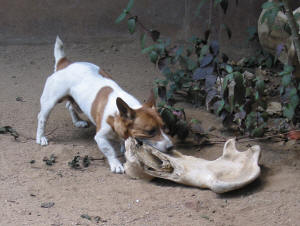 Milo
is a feisty Jack Russell terrier belonging to one of the Flatdogs’ owners.
Being a typically overconfident little dog, Milo delights in chasing
baboons. Baboons can be big animals with males weighing upwards of 60
pounds or more. Baboons also have very big teeth. Milo doesn’t
seem bothered by any of these things as he happily chases off after them
barking furiously. Last week a herd of elephants apparently invaded
Milo’s territory near his house. Milo chased after the elephants, and
one of them turned and charged trumpeting with his trunk in the air and ears
out. Milo was undeterred and apparently just kept running barking
towards the elephant. The elephant became so confused by this
impossibly crazy dog that he turned around and ran away. Milo
is a feisty Jack Russell terrier belonging to one of the Flatdogs’ owners.
Being a typically overconfident little dog, Milo delights in chasing
baboons. Baboons can be big animals with males weighing upwards of 60
pounds or more. Baboons also have very big teeth. Milo doesn’t
seem bothered by any of these things as he happily chases off after them
barking furiously. Last week a herd of elephants apparently invaded
Milo’s territory near his house. Milo chased after the elephants, and
one of them turned and charged trumpeting with his trunk in the air and ears
out. Milo was undeterred and apparently just kept running barking
towards the elephant. The elephant became so confused by this
impossibly crazy dog that he turned around and ran away.
 Milo
has a partner in crime, Daisy, a short-haired and sometimes short-tempered
African mongrel rescued from the village to a life of luxury. Daisy’s
African heritage must give her some local common sense. She chases
baboons but not elephants. Milo
has a partner in crime, Daisy, a short-haired and sometimes short-tempered
African mongrel rescued from the village to a life of luxury. Daisy’s
African heritage must give her some local common sense. She chases
baboons but not elephants.
Daisy and Milo live with two of Mfuwe’s
more interesting mzungus, i.e. white people. Jake and Gillie met here
fifteen years ago.
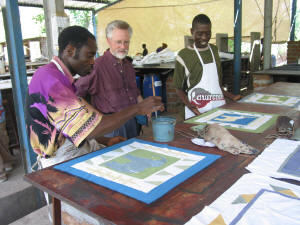 While
he has built and run Flatdogs Camp, Gillie has masterminded an amazing
fabric design company called Tribal Textiles (http://www.tribaltextiles.co.zm/)
which now employs 200 local people making African-inspired hand painted
textiles for export. The other Mzungus around are an interesting lot,
hailing from South Africa, Zimbabwe, the UK, Holland, and even the USA.
Some are here for a few months of adventure. Most can’t imagine
returning to a desk job back home. While
he has built and run Flatdogs Camp, Gillie has masterminded an amazing
fabric design company called Tribal Textiles (http://www.tribaltextiles.co.zm/)
which now employs 200 local people making African-inspired hand painted
textiles for export. The other Mzungus around are an interesting lot,
hailing from South Africa, Zimbabwe, the UK, Holland, and even the USA.
Some are here for a few months of adventure. Most can’t imagine
returning to a desk job back home.
So I am now the “Mzungu Doctolo”.
Quite a few of the local kids see my white face and start screaming and
crying hysterically which makes examining them almost impossible and hurts
my feelings since I’ve usually been good with kids at work.
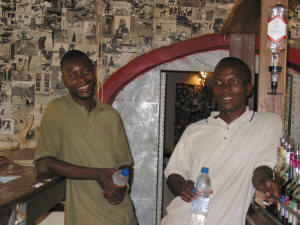 The guys at the bar (where I hang out at night drinking my
favorite soda water and lime juice or granadilla) are teaching me Nyanja,
the local language. I think they can be trusted not to teach me any
bad words, but when I try to speak my very little bit of Nyanja to the
screaming kids, they just scream louder while the Moms laugh. Maybe I
should be more suspicious of the bar men! Usually though, I can
reassure myself that if the kid can put up that much of a fuss he can’t be
too sick. The guys at the bar (where I hang out at night drinking my
favorite soda water and lime juice or granadilla) are teaching me Nyanja,
the local language. I think they can be trusted not to teach me any
bad words, but when I try to speak my very little bit of Nyanja to the
screaming kids, they just scream louder while the Moms laugh. Maybe I
should be more suspicious of the bar men! Usually though, I can
reassure myself that if the kid can put up that much of a fuss he can’t be
too sick.
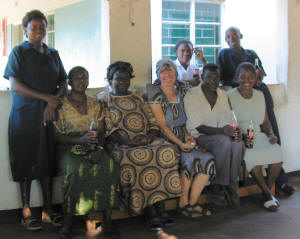 I’m beginning to know the clinic staff a bit better and
feel I’m being more helpful. Today we had a four-year-old girl whose
cotton dress caught on fire burning her front torso, thighs and arms.
All we could do was wash off the local remedy of egg the family had applied,
dress the wounds with Vaseline gauze and bandages, give her Paracetamol
(essentially Tylenol) which is all we have for pain, give her a tetanus
booster and send her one hour away to the hospital. In the last week, two
patients with new “grand mal” seizures have come in to the clinic
highlighting our lack of diagnostic ability. I have a long list of
possible causes in my head, but in the end I, and the hospital an hour away,
can test for almost none of them. At home a brain CAT scan or MRI
would be near the top of the list of tests. Here only one or two of
those machines exist in the entire country, all in Lusaka -- an impossibly
long expensive journey away for a local. So we treat them for what we
can and hope for the best. Very unsatisfying! I’m beginning to know the clinic staff a bit better and
feel I’m being more helpful. Today we had a four-year-old girl whose
cotton dress caught on fire burning her front torso, thighs and arms.
All we could do was wash off the local remedy of egg the family had applied,
dress the wounds with Vaseline gauze and bandages, give her Paracetamol
(essentially Tylenol) which is all we have for pain, give her a tetanus
booster and send her one hour away to the hospital. In the last week, two
patients with new “grand mal” seizures have come in to the clinic
highlighting our lack of diagnostic ability. I have a long list of
possible causes in my head, but in the end I, and the hospital an hour away,
can test for almost none of them. At home a brain CAT scan or MRI
would be near the top of the list of tests. Here only one or two of
those machines exist in the entire country, all in Lusaka -- an impossibly
long expensive journey away for a local. So we treat them for what we
can and hope for the best. Very unsatisfying!
This morning a 37-year-old man died at the
clinic, probably from meningitis. Though he had never been tested, I’m
sure he had AIDS. Every day I see several patients, both adults and
children, with manifestations of HIV infection. I think the official
number that 20% of the population is HIV positive is probably far too low.
Even though anti-HIV medicines are now theoretically available in Kamoto,
none of the patients, or the staff for that matter, seems to understand how
to go about getting them. The patients who do manage to get them are
so sick by the time the drugs are started that they die anyway with full
bottles of the medicine at their bedside. It’s hard to be optimistic that
even a small percentage of the population (like HIV positive pregnant women)
will be efficiently treated under the current scheme.
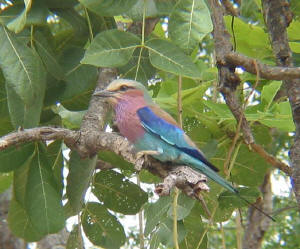 The
animals continue to be my prime diversion from the sadness and challenges of
the clinic. Though the monkeys are cheeky, I’m fascinated by their
behavior. This morning I watched four little monkeys chasing each
other through the trees and leaping from branch to branch. A couple of
“mom” monkeys with teeny-weeny babies clutched to their bellies watched from
a distance. Tonight, a hyena was calling very close to my house,
though I’ve yet to see one here. In the mornings I’m enjoying watching
the extraordinary variety of bird life, from LBJs (little brown jobs) to
iridescent Carmine Bee Eaters to the Lilac Breasted Roller (a ridiculously
beautiful little bird with a violet breast, purple epaulets, green belly and
brilliant blue wings) to Marabou storks, African fish eagles and sacred
ibis. The list goes on and on. Quite fascinating! The
animals continue to be my prime diversion from the sadness and challenges of
the clinic. Though the monkeys are cheeky, I’m fascinated by their
behavior. This morning I watched four little monkeys chasing each
other through the trees and leaping from branch to branch. A couple of
“mom” monkeys with teeny-weeny babies clutched to their bellies watched from
a distance. Tonight, a hyena was calling very close to my house,
though I’ve yet to see one here. In the mornings I’m enjoying watching
the extraordinary variety of bird life, from LBJs (little brown jobs) to
iridescent Carmine Bee Eaters to the Lilac Breasted Roller (a ridiculously
beautiful little bird with a violet breast, purple epaulets, green belly and
brilliant blue wings) to Marabou storks, African fish eagles and sacred
ibis. The list goes on and on. Quite fascinating!
 Tonight a flock of white egrets flew in formation across
the pink-orange clouds just at sunset. Crocodiles rested on the river
bank a few hundred yards away, and the hippos began their evening honking
and snorting. A remarkable place to spend some time -- even if it is
bloody hot for us mzungus. Tonight a flock of white egrets flew in formation across
the pink-orange clouds just at sunset. Crocodiles rested on the river
bank a few hundred yards away, and the hippos began their evening honking
and snorting. A remarkable place to spend some time -- even if it is
bloody hot for us mzungus.
|
















